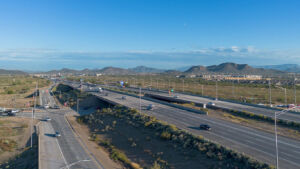Salt River Pima-Maricopa Indian Community may have one of the best-located pieces of commercial real estate in the Phoenix Metro. It owns a 9.5-mile long area, known as the Pima Corridor, parallel to the Loop 101, a beltway connected to nearly all area freeways. Of that commercially zoned stretch, 143 acres remain undeveloped. Many Valley residents primarily associate the Talking Stick entertainment district with the Pima Corridor, the SRPMIC is seeking significant non-entertainment development within and without Talking Stick, including two charter schools and also procuring resources to update its existing data center.
“The SRPMIC is a pretty sophisticated community and as the community grows in population and business ventures, the adoption of technology also grows,” says SmithGroupJJR’s Technology Studio Leader Rob Sty. “[Records are] all stored electronically now. The community has gotten to the point that it needs to expand its data.”
As with any building on the community’s land, the data center must incorporate the culture’s aesthetic integrity. The challenge is that data centers, out of concern for security, tend to also be designed as background buildings.
“Architects and engineers do not always get to put that design element into a data center. It’s interesting for us,” Sty says, adding that designing a project for the SRPMIC was a community effort: “It’s a lot more interesting when all the groups are engaged. Everyone has a voice, and you come out with a better project.”
NOTCHES ON A TALKING STICK
A Talking Stick is a contemporary representation of the traditional O’odham (Pima) calendar stick, on which carvers recorded significant events and milestones throughout the year. It is also the namesake of the Salt River Pima-Maricopa Indian Community’s entertainment district, which comprises about half of the tribes’ commercial land reserves. Talking Stick is a 1.1 MSF entertainment district consisting of a casino, resort, golf course, spring training facility and retail center called The Pavilions. Opened in the ‘80s, the Pavilions represents the second carving on Talking Stick’s calendar — the first being the union of the two tribes who comprise the community. The bottom of the stick shows vacant space with room to grow — and one of the many projects underway this year and next may just be the next addition.
The 1.1MSF Talking Stick’s build-up is due to a pro-development attitude of the community leaders as well as developers keen on getting their foot in the door of a burgeoning entertainment district. Since much of the traffic speeds by Talking Stick at 65 mph, designing for the corridor requires those such as PHX Architecture’s Erik Peterson to not only create something fun to visit but also something eye-catching from afar.
Peterson’s design for The Cove Family Fun Center, a metallic mesh-wrapped building with blue accent lighting around it is certainly made to pique the attention of freeway passengers. The building has to capture your attention, he says of his recent work on The Cove Family Fun Center — a 60KSF entertainment center. The basket-like building is set to break ground on SRPMIC later this year. Nick Andrews, developer of The Cove, was drawn to the Salt-River Pima Indian Community for his first project on tribal land due to the community’s proactive reputation.
“They’re really pro-growth when it comes to developers like us who have an entertainment-related venue,” Andrews says.
Just in the last 12 months, Talking Stick has seen development of a Courtyard Marriott, OdySea projects, Top Golf and other attractions. Blessing McAnlis-Vasquez, marketing project manager of Talking Stick, says it’s a combination of tribal leadership and private developers’ vision for tourism and entertainment amenities that has led to its recent success.
“Our leadership always looks ahead seven generations,” McAnlis-Vasquez says, though the present is just as exciting.
Though the SRPMIC has a population of 6,000, Salt River Fields, built in 2009, has more than 12 annual events, some of which bring up to 15,000 guests. The proposed OdySea Aquarium, set to break ground later this year, is designed to accommodate 15,000 visitors a day and will be the largest aquarium in the Southwest. Leasing at the Pavilions is at 87 percent, up from 50 percent at the downturn of the recession.
The shopping center has also seen more than $17M in renovations. Though The Cove Family Fun Center hasn’t signed a lease yet, the 60KSF entertainment venue is working proactively with the tribe to open for business by summer 2015.
THE RISE, FALL & REBIRTH OF THE PAVILIONS
When the Pavilions at Talking Stick was built, it was the freshest take on retail super centers. As time passed, ownership and management changed hands and the center fell into disrepair. Marty De Rito and business partner Chuck Carlise scooped up the property for $85M in January 2008 with 85 percent of the property leased. In 10 months, the recession dropped vacancy to 50 percent. Six years later, De Rito is just now breaking even on its purchase.
“This property could have taken our company down,” Carlise says. “Fortunately, now we’re about 87 percent leased. The tribe has been phenomenal in assisting us with the renaissance of this property.”
Just like the road through the center of the Pavilions to SRF, it goes both ways.
It was De Rito who got wind of the Diamondbacks’ desire to move north for spring training in 2009, and Carlise attributes his partner to bringing what would be a catalyst for the entire district to Salt River Fields.
“It’s an interesting thing when you have non-retail activity going on at the center. Salt River Fields helped this property to survive,” Carlise says.
Though SRF was a catalyst for businesses built up around the area and meant a surge of restaurant interest in Pavilions space, there was still one more hurdle De Rito Partners looked to clear — alcohol.
Until 2010, the only establishments that could serve liquor on tribal land were the hotel, casino and golf course — all owned by SRPMIC. De Rito Partners couldn’t bring restaurant tenants to the Pavilions if they needed a liquor license. Now, there’s a Red Robin under construction as well as business with Buffalo Wild Wings.
“There was no barrier for entry after that,” Carlise says.
The other saving graces for the Pavilions — lending (De Rito’s lender was General Electric, a bit more flexible than a regulated bank would have been) and moving an office to the Pavilions.
“We’ve probably saved half a million dollars just being onsite,” Carlise says, adding that the added attention to the property is what has contributed to the Pavilions’ return to its potential.
PROJECTS IN THE PIPELINE
OdySea Aquarium
 Development and Management Team: Amram Knishinsky, Martin Pollack and Rubin Stahl
Development and Management Team: Amram Knishinsky, Martin Pollack and Rubin Stahl
General Contractor: McCarthy Building Companies
Architect: Deutsch Architecture Group
Location: Via De Ventura and the 101 in Scottsdale at
the Salt River Pima-Maricopa Indian Community
Size: 200KSF
Brokerage Firm: N/A
Value: $175M
Estimated completion date: 4Q 2015
The OdySea Aquarium will be the largest aquarium in the Southwest and in the unlikely setting of the Sonoran desert. The two-level facility will span more than 200KSF, and visitors will move to each level via acrylic tunnels while viewing animals of rivers and oceans in the world.
 Noah Webster School – Pima Campus
Noah Webster School – Pima Campus
Developer: Noah Webster Schools & Salt River Devco
General Contractor: Adolfson & Peterson Construction
Architect: Adolfson & Peterson Construction
Location: Pima & Jackrabbit roads, Scottsdale
Size: 51,502 SF
Value: $5.4M
Completed date: July 2014
The two-story framed K-6 charter school facility will feature 32 classrooms, including music and art rooms, a multi-purpose gym with cafeteria and stage, office space, conference rooms, play fields and bus parking. The project has been in planning and design for a number of years and the groundbreaking represents a significant milestone for Noah Webster Basic School and the Salt River Pima-Maricopa Indian Community’s STEM education.
Great Hearts Academy – Cicero Campus
 Developer: De Rito Partners Development
Developer: De Rito Partners Development
General Contractor: Chasse Building Team
Architect: Gensler
Location: NWC Loop 101 & Indian Bend Road, Salt River Pima-Maricopa Indian Community
Size: 85KSF
Brokerage Firm: Keyser/Mulhern Development Team
Value: $10M
Estimated completion date: July 2014
This nonprofit, tuition-free K-12 charter school will cater to 1,200 children in an area that was once occupied by a Chuck E. Cheese at the Pavilions Shopping Center. Phase I will accommodate students in grade K-7 and Phase II to 12th grade.
The Cove Family Fun Center
 Project Name: The Cove Family Fun Center
Project Name: The Cove Family Fun Center
Developer: Nick Andrews & David Prom
General Contractor: AR Mays Construction
Architect: PHX Architecture
Location: NEC of the Loop 101 Via de Ventura Interchange on the Salt River-Pima Maricopa Indian Community
Size: 67KSF
Value: $13M
Estimated completion date: Summer 2015
The Cove Family Fun Center is slated to include 19 themed birthday/event rooms, laser tag, bowling, arcade games, laser tag and go-karts.



